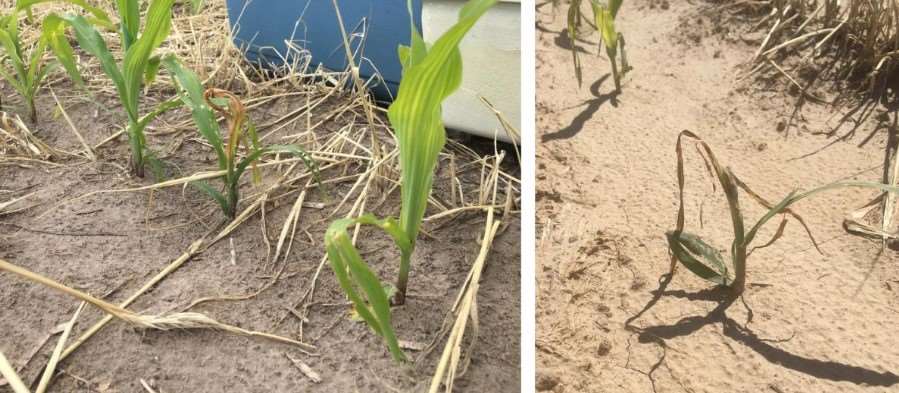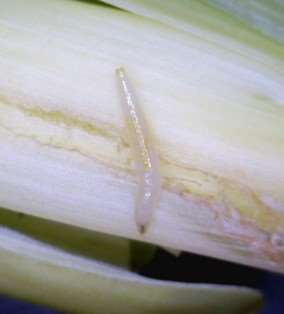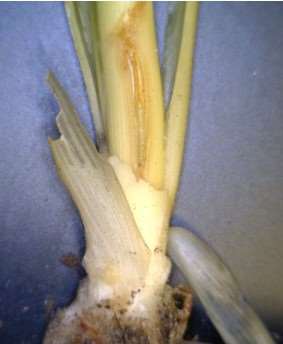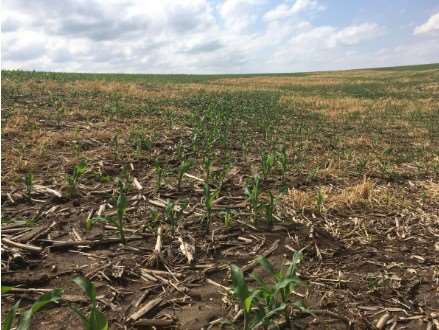By Justin McMechan - Crop Protection and Cropping Systems Specialist
Robert Wright - Extension Entomologist
Wayne Ohnesorg - Extension Educator
University of Nebraska-Lincoln
Institute of Agriculture and Natural Resources
CROPWATCH
On May 30 a number of agricultural professionals across central and eastern Nebraska reported insects damaging corn following rye and wheat cover crops. At the time of sampling, corn plants were in the V2-V4 stage exhibiting “dead heart” symptoms. Infested plants became more evident within one to two weeks of the initial symptoms with little to no growth or excessive tillering (Figure 1). A number of these symptomatic plants were sampled and dissected, revealing small larvae, suspected to be wheat stem maggot (WSM) Meromyza americana (Figure 2). This is not the first report of WSM in corn in Nebraska. In 2005, 2015, and 2016 similar reports were made of wheat stem maggot damaging corn and causing 5-10% stand loss in northeast Nebraska fields.

Figure 1. Corn plants showing varying levels of response from wheat stem maggot infestation at early plant growth stages. Infested plants showed signs of tillering, stunting, and wrapped or tied leaves.
Due to the widespread damage, a survey was initiated to assess losses and identify factors common to damaged fields. Stand losses in fields ranged from 2%-30% on a whole-field basis. At each field, a total of 50 symptomatic plants were sampled with half of the plants dissected to isolate larvae and the other half transplanted to containers with cages to capture adults upon emergence for insect identification. Dissections revealed a wide range in larvae development, ranging from 3-6 mm in length, indicating multiple instars were present. In most cases, only a single maggot was found per plant, with the exception of a few plants with two maggots. Unlike reports in 2015, it appears maggots entered through the top center whorl of the plant as indicated by a feeding channel that extended down to the growing point (Figure 3). Larger larvae (5-6 mm) were found midway up the plant, suggesting movement back toward the top of the plant

Figure 2. Larva suspected to be wheat stem maggot isolated from symptomatic plant. Feeding channel visible from left to right representing top to bottom of the plant, respectively.

Figure 3. Larva burrowing down to the growing point of a corn plant. Bottom of photo shows the growing point, approximately ¾ inch below the soil surface.
Affected corn fields ranged considerably in the timing of establishment and termination of the cover crop. In all cases, the cover crop was still alive at the time of corn planting. Terminating rye cover crops after corn planting has been suggested as a way of avoiding allelopathic effects from the rye. (See “Planting Corn into a Cereal Rye Cover Crop for more information). In most cases, the entire field was planted to a cover crop; however, a few producers had planted only small portions of the field for erosion control on field slopes. In such situations, infested and damaged plants were confined to these areas with normally developing corn plants occurring within 1-2 feet of the cover crop (Figure 4). The lack of significant spread from the cover crop suggests that larval movement between cover crop and corn may have been the primary factor for infestation

Figure 4. Rye cover crop planted in small sections of a field for erosion control. Center of photo shows a section of ground where cover crop did not establish with normally developing plants. Damage corn plants were primarily restricted to areas where cover crop was present.
Little to no information is available on wheat stem maggot in corn. In general, adults overwinter as larvae in the stems of host plants (wheat, rye, barley, and a number of wild grasses), pupating in early spring with adult emergence in May/June. In our survey, we were still finding larvae within corn plants sampled on June 9. While the maggots can complete development to the adult stage on corn, it is not know if adult WSM will lay eggs on corn. Since corn is not listed as a preferred host, we would expect that adults would leave affected corn fields to lay eggs in nearby wild or weedy grasses. Previous literature indicates two or more generations per year could be expected in Nebraska.
Management
We do not recommend any control measures for this year’s corn crop. This is primarily due to the inability to get any insecticidal chemistries to the insect and the fact that plant damage has already occurred. The damaged corn fields in 2015 had Poncho seed treatment rates ranging form low to high levels and did not provide effective control.
To avoid damage to next year’s crop, it would be best to terminate cover crops two to three weeks prior to planting, allowing for the cover crop to be completely dead prior to planting. Such practices will limit the total biomass achieved by the cover crop.
To gain a better understanding of this situation we will be conducting field studies at the Eastern Nebraska Research and Extension Center near Mead (formerly ARDC) this fall to help provide additional management recommendations.
Source: unl.edu